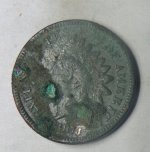P
Pentico
Guest
Moffat Tunnel
Elevation 9,239 feet at crest.
Denver 50.18 to 56.39 miles.
One of the most famous railroad tunnels in America at over 6 miles long, the Moffat Tunnel penetrates James Peak and the continental divide to eliminate the severe hardship of operating tracks over the highest parts of Rollins Pass.
The tunnel was supported by David Moffat of the Denver, Northwestern and Pacific (DNW&P) railroad as early as 1902. The original DNW&P tracks climbed Rollins Pass with a series of switch back loops requiring steep grades and experiencing severe snow conditions. In fact, removing snow from the original line made it non-profitable to operate.
Try as he might, Moffat could not raise the funding required to build the tunnel before he passed away, never seeing his lifetime railroad dream become a success. But the force behind the tunnel continued on, and in 1914 a Denver bond issue was approved to finance two thirds of the construction cost of the tunnel. However, the issue was defeated in the courts when it was found that Denver did not have the constitutional right to enter into a joint venture to construct the tunnel with a private corporation. It was not until 1922, when the Colorado state government enacted a bill to fund a tunnel improvement district, that construction finally got underway.
From the onset of construction, it became apparent that the tunnel was going to be as hard to build as it was to finance. Geologic conditions on the west face were much worse than originally anticipated. Where there was thought to be solid rock, there was in fact severely fractured stone and heaving earth. Subterranean pressures would push in on the sides of the excavation making it slowly cave and uplift. Shoring was required all around the tunnel to maintain it. Water would occasionally burst in and flood the bore. It was thought that lakes above the tunnel were draining through cracks in the mountain and into the cavity itself. Never the less, the engineers were clever and found ways of dealing with the project.
Construction was accomplished by first digging a smaller, pioneer tunnel, next to the location of the larger tunnel. This smaller tunnel could then be used to cut side bores into the path of the larger tunnel allowing work to proceed at multiple locations along its length. After construction was completed, the pioneer tunnel became an aqueduct to supply water for the City of Denver.
Construction was completed in 1927 at a total cost of 18 million dollars, three times the cost of the original estimate.
The tunnel was dug with vertical apex grades that created a hill in the center of the bore. This somewhat controversial grade was required for various reasons including proper drainage. It meant that smoke from the engines would rise to the apex and therefore the whole tunnel required a ventilation system. At the tunnel portals the openings had canvas doors that would be closed to help the ventilation system operate. Detectors in the track would open the doors eight seconds before the train arrived and then close them after passing. Sometimes the trains would actually crash through the doors so they were constructed of canvas that could easily be replaced.
Originally the tunnel was lined with timber shoring and this was later replaced with a concrete lining.
Thanks to Denver and the Rio Grande RR
A few pictures of the trip up this morning.
Peace
Elevation 9,239 feet at crest.
Denver 50.18 to 56.39 miles.
One of the most famous railroad tunnels in America at over 6 miles long, the Moffat Tunnel penetrates James Peak and the continental divide to eliminate the severe hardship of operating tracks over the highest parts of Rollins Pass.
The tunnel was supported by David Moffat of the Denver, Northwestern and Pacific (DNW&P) railroad as early as 1902. The original DNW&P tracks climbed Rollins Pass with a series of switch back loops requiring steep grades and experiencing severe snow conditions. In fact, removing snow from the original line made it non-profitable to operate.
Try as he might, Moffat could not raise the funding required to build the tunnel before he passed away, never seeing his lifetime railroad dream become a success. But the force behind the tunnel continued on, and in 1914 a Denver bond issue was approved to finance two thirds of the construction cost of the tunnel. However, the issue was defeated in the courts when it was found that Denver did not have the constitutional right to enter into a joint venture to construct the tunnel with a private corporation. It was not until 1922, when the Colorado state government enacted a bill to fund a tunnel improvement district, that construction finally got underway.
From the onset of construction, it became apparent that the tunnel was going to be as hard to build as it was to finance. Geologic conditions on the west face were much worse than originally anticipated. Where there was thought to be solid rock, there was in fact severely fractured stone and heaving earth. Subterranean pressures would push in on the sides of the excavation making it slowly cave and uplift. Shoring was required all around the tunnel to maintain it. Water would occasionally burst in and flood the bore. It was thought that lakes above the tunnel were draining through cracks in the mountain and into the cavity itself. Never the less, the engineers were clever and found ways of dealing with the project.
Construction was accomplished by first digging a smaller, pioneer tunnel, next to the location of the larger tunnel. This smaller tunnel could then be used to cut side bores into the path of the larger tunnel allowing work to proceed at multiple locations along its length. After construction was completed, the pioneer tunnel became an aqueduct to supply water for the City of Denver.
Construction was completed in 1927 at a total cost of 18 million dollars, three times the cost of the original estimate.
The tunnel was dug with vertical apex grades that created a hill in the center of the bore. This somewhat controversial grade was required for various reasons including proper drainage. It meant that smoke from the engines would rise to the apex and therefore the whole tunnel required a ventilation system. At the tunnel portals the openings had canvas doors that would be closed to help the ventilation system operate. Detectors in the track would open the doors eight seconds before the train arrived and then close them after passing. Sometimes the trains would actually crash through the doors so they were constructed of canvas that could easily be replaced.
Originally the tunnel was lined with timber shoring and this was later replaced with a concrete lining.
Thanks to Denver and the Rio Grande RR
A few pictures of the trip up this morning.
Peace


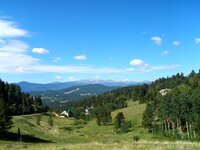
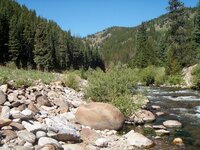
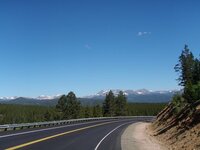
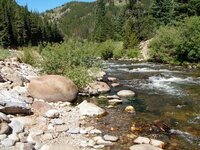
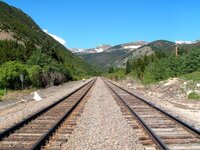
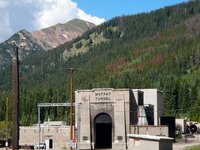

 ?!?! Very cool!
?!?! Very cool!

